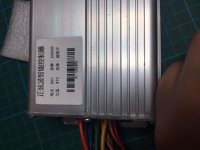As long as the load of the system is enough to require more watts, then you actually need to change both, *and* the battery (but you already did this). However, most motors are capable of more than their "ratings" (whcih are usually next to meaningless except under the specific conditions they were lab-tested at to get those ratings, if they *were* tested at all).
Generally you need a higher wattage motor if it is getting too hot while under the load your system puts on it. If it's not hot, higher wattage motor itself won't change anything.
As previously noted, it depends on your load, meaning how much work the system has to do.
If there is not enough load, it wont' demand more than a certain watts, and it won't matter how big a motor, controller, and battery you have, it will never go beyond those watts.
FWIW, if you post all the info that is on the label of the old controller, and all that is on the new controller, we might see something that indicates the problem. (probably not, but worht a shot). Usually the current limit is the most important thing, but any info might help.
The thing you might be running into, however, is a speed "limit", which effectively limits what you can do.
Sometimes this limit is the controller, where it actually has a speed limit on how fast it will allow the motor to spin. Usually this means it has a display or a computer-based programming utility that lets you set the wheel size (because without knowing that, the controller can't know how fast you're going). You can check with the seller or manufacturer of the controller to see about this.
Some controllers also have programmable current limits, and may not be set to their maximum by the factory. They may require you to hook it up to a computer and use the factory-provided software (whcih may not be avaialble to you) to change it. So while the controller is technically capable of more power, and is advertised as such, you can't actually *use* that power because of the settings you can't access.
Some controllers are advertised as a certain wattage, but stil have the same current limit as a lower wattage controller. This means that on the same voltage system, they wll both be the same wattage. It would take a higher voltage system to get the higher wattage out of the controller (assuming it is capable of a higher voltage).
Sometimes the wattage rating of a controller (or motor, etc) is just marketing, and isn't actually true.
More often, the limit is just the motor winding, meaning that for a given voltage it will only spin so fast. To get more speed (or power) out of it you'd have to increase the system voltage, meanign a higher voltage battery (and controller that can handle that voltage, along with anything else on the scooter like the DC-DC that runs the lights, etc).
Or change the motor to one meant to run at the speed you want at the voltage you already have.


